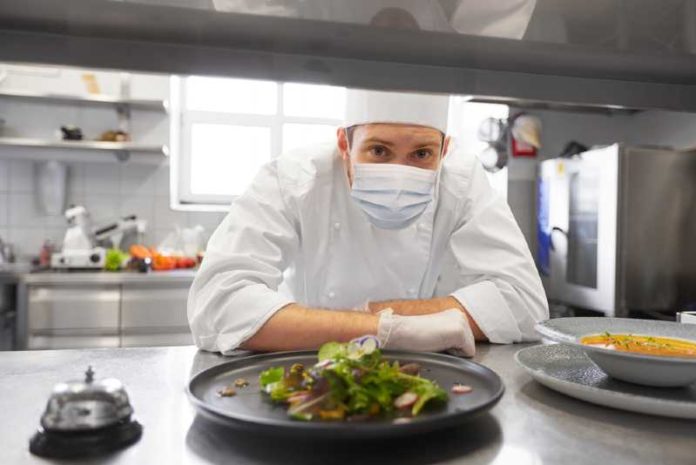How five Cs—communication, contactless, curbside, cloud and cleanliness—will govern the future of restaurants
While eating out may seem nothing more than a convenience or luxury to some, restaurants are vital to the U.S. economy, contributing $2.5 trillion to the economy annually and employing approximately 15.6 million people—roughly one in 10 working Americans—according to the National Restaurant Association. In a pre-COVID report, the association predicted annual sales would hit $899 billion in 2020 and employment numbers would reach 17.2 million by 2030. But in an April survey, not only were all expectations off the table, but three decades of employment progress had been wiped out between March and May, with an estimated 8 million restaurant employees laid off or furloughed as a result of the coronavirus.
Before the pandemic hit, the restaurant industry had long been notorious for its high risk of failure, particularly within the first five years. But it never stopped intrepid restaurateurs from rolling the dice. In 2018, for example, 13,251 new restaurants opened in the U.S., according to Statista, reflecting a 2 percent increase from 2017. Now, after two rounds of shutdowns, even long-standing local mainstays are struggling to survive, with some industry insiders predicting that 85 percent of independent restaurants (which account for 70 percent of all establishments) will close by the end of the year.
To stay afloat, dine-in restaurants in many cities are hauling their tables outside into city streets, parking lots and onto sidewalks to compensate for the lost indoor space. And so far, it’s working, even in New York City, which was considered the epicenter of the crisis early on. With the local government initiating an Open Streets: Restaurants program, dining has been given a lifeline with outdoor seating, which will be allowed at least until October 31 when the government deadline expires. In places like Southern California, where the weather is ideal, this can go on all year long. In colder climates, however, more creativity will be required. Adding open tents with heaters may be a solution to expand beyond October. However, when heavy snow falls, it’s likely not sustainable. But, then again, this is the restaurant industry, and it’s filled with people who do not easily lose hope.
Take Lex Gopnik-Lewinski of Augie’s Montreal Deli in Berkeley, Calif., for example. By implementing a technology that converted his landline into a textable number, he was able to keep his doors “open” and his customer calls and requests answered—even when his authentic Montreal-style Jewish delicatessen was closed. He’s now using text messaging to successfully communicate with customers from his restaurant, which had to quickly transition from indoor dining to outside pickup when stay-at-home mandates were issued.
Pre-COVID, Lex estimates that approximately 60 percent of his business was dine-in customers. Now, about 90 percent of sales are coming through his virtual receptionist platform via text messaging, which has also served as a contactless, cost-saving alternative to third-party delivery apps that charge hefty fees. In fact, for restaurants relying on food delivery apps, it wasn’t long before they realized the high price they were paying. While GrubHub, DoorDash, UberEats and others have enabled many to keep serving customers, they are charging 20 to 40 percent per order for their services. It’s one of the reasons restaurants are quickly adopting these contactless digital solutions and curbside pickup that bypass the middle man. Not that delivery is going away anytime soon. It has been around for quite some time—not as long as takeout, however—and driven by the millennial appetite for instant gratification. Just like contactless ordering and curbside pickup, delivery will likely become a part of restaurants’ expanded offerings.
Whether embracing a few or all of the five Cs, the Cloud will play an integral role, particularly for those ready to evolve to ghost, or cloud, kitchens. Solving the ongoing challenge of high rent and premium real estate in prime downtown locales, ghost kitchens will eliminate overhead—from staff to silverware—while enabling restaurateurs to cater to a wider clientele. Again, the concept has been around for a few years, but there is no doubt that the pandemic will accelerate adoption if it hasn’t already. In the June 2020 issue of the New Yorker, an article titled “Our Ghost-kitchen Future” points out the fact that many restaurants in cities with bans on indoor dining are already operation in some variation of a ghost kitchen, taking orders online or by phone and allowing curbside pickup and home delivery. In the future, it is plausible that more will opt for low-rent warehouse space or trailers and offer a dozen different cuisines, much like the traditional food court in malls across America, but without the foot traffic.
Yes, restaurants are getting creative. Even with subscription-based meal kits, take-and-bake and ready-to-eat family dinners added to the mix, there is no doubt people will still enjoy an evening out at a dine-in establishment. The big difference customers can expect is that they will be indulged like never before, with a guarantee of attentiveness, cleanliness and food safety at the core—regardless of how or where a meal is consumed.
As 2020 continues to play out, it’s worth noting these additional industry statistics from the National Restaurant Association and why it is critical to keep this sector alive:
- Restaurants employ more minority managers than any other industry
- 63 percent of consumers would rather spend on an experience than purchase an item
- The number of middle-class jobs ($45K-$75K) in the industry grew 84 percent between 2010 and 2018, more than 3 times faster than in the overall economy
What the future holds is truly anyone’s guess, but by embracing the five Cs—communication, contactless, curbside, cloud and cleanliness—restaurants may do more than increase their chances of survival. They may thrive in ways previously unimaginable.
Tasso Roumeliotiss is currently the CEO & Co-Founder off Numa. Previously he was an Entrepreneur in Residence at Silicon Valley-based venture capital firm, DFJ and also founded Location Labs, an early pioneer in mobile and location-based technology.
Restaurants stock photo by Syda Productions/Shutterstock







